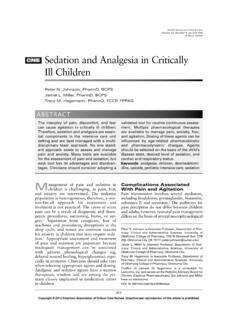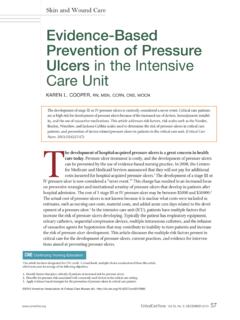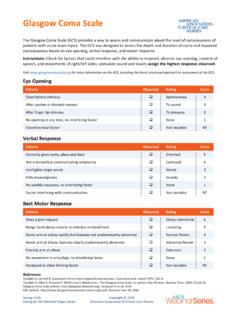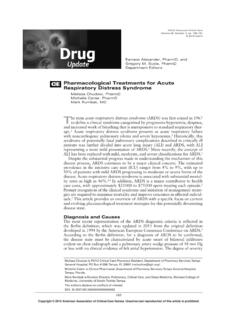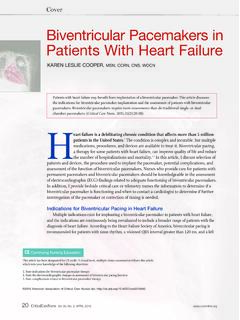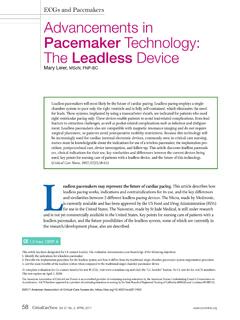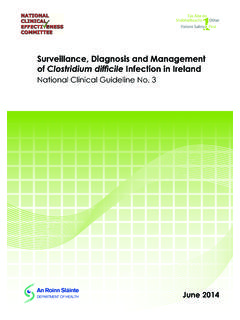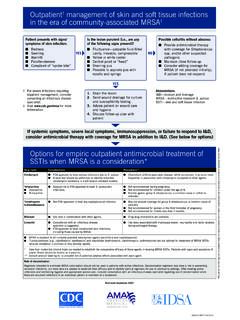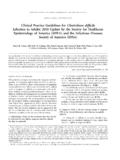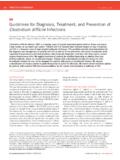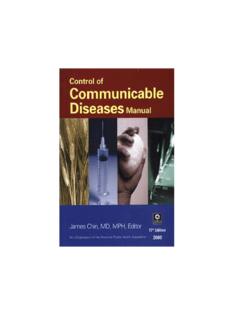Transcription of Clostridium difficileInfection Clinical Challengesand ...
1 Clostridium difficile ,an anaerobic, spore-forming, toxin-forming, gram-positive bacillus, hasbecome the leading cause of health care associated infectious ,2 The spectrum of C difficileInfection (CDI) ranges from uncomplicated diarrhea to systemic toxic effects markedby sepsis and cases, requiring colectomy, have a mortality rate up to 80%.3 CDI isincreasingly common and causes marked morbidity and mortality, prolonged hospital lengths of stay,and increased health care costs. Recent excess health care costs of hospital-onset CDI are estimated tobe $5042 to $7179 per case, with a national annual estimate (limited to hospital-onset CDI) of $897million to $ emergence of a hypervirulent epidemic strain and community-acquireddisease in populations previously at low risk for CDI most likely will place an even greater burden onpatients and the health care difficileInfectionClinical Challengesand Management StrategiesPAMELA R.
2 WALTERS, RN, MSN, ACNP-BCBRIAN S. ZUCKERBRAUN, MD 2014 American Association of Critical-Care Nurses doi: difficilehas become the leading cause of nosocomial diarrhea in adults. A substantial increase hasoccurred in morbidity and mortality associated with disease caused by C difficileand in the identification ofnew hypervirulent strains, warranting a high Clinical index of suspicion for infections due to this of infection requires a multidisciplinary approach, including early recognition of disease, effectivecontact isolation precautions, adherence to disinfectant policies, and judicious use of antibiotics. Current treat-ment approaches are based on the severity of illness. As hypervirulent strains evolve, unsuccessful treatmentsare more common. Complicated colitis caused by C difficilemay benefit from surgical intervention.
3 Subtotalcolectomy and end ileostomy have been the procedures of choice, but are associated with a high mortality ratebecause of late surgical consultation and use of surgery as a salvage therapy. A promising surgical alternative iscreation of a diverting loop ileostomy with colonic lavage. (Critical Care Nurse. 2014;34[4]:24-35)This article has been designated for CNE credit. A closed-book, multiple-choice examination follows this article,which tests your knowledge of the following objectives:1. Identify symptoms of Clostridium difficileInfection (CDI)2. Describe strategies to prevent transmission of CDI3. Identify treatment options for CDICNE Continuing Nursing Education24 CriticalCareNurseVol 34, No. 4, AUGUST and PathogenesisWhereas other hospital- associated infections havedeclined since 2001, the incidence of CDI has from the Agency of Healthcare Research andQuality5,6indicate that the number of CDI diagnoses atthe time of hospital discharge more than doubled in theUnited States, from 139 000 to 301 200, from 2001 through2005.
4 According to Redelings et al,7reported mortalityrates for C difficiledisease in the United States increasedfrom per million population in 1999 to per mil-lion in 2004. The upward trend continues, according to a2008 Nationwide Inpatient Sample,6which recorded nearly350 000 CDI diagnoses at the time of discharge from acutecare hospitals. Currently, C difficileis estimated to be respon-sible for more than 500 000 infections each year, the major-ity of which are hospital alarming is the9% mortality associated with CDI compared with less than2% for all other types of the incidence ofCDI increases, so does the severity of the greatest concern about CDI is its progression tocomplicated or fulminant colitis, which is often refractoryto medical management. Progression is often rapid andcan lead to shock and death despite treatment.
5 Increasesin the severity of CDI may be related to its evolving viru-lence since 1990. Most notably, a 2003 review10of 1771cases in Quebec, Canada, later identified as an outbreak,revealed that the number of CDI cases had more thanquadrupled since 1991. The marked increases in frequencyand severity of this outbreak were attributed to a single,hypervirulent strain that was present in 82% of the patientsin this strain is known as ClostridiumdifficileNAB1/BI/027 or NAP-1/027,11and it has beenlinked to changes in disease pathogenesis in both Europeand North America. Since its emergence, NAP-1/027 has been directlylinked to increased mortality due to fulminant have described several unique properties ofthis strain that account for fulminant colitis. The majorvirulence determinants of CDI are its ability to hyperpro-duce toxins A and B and to produce a binary toxin, whichare notable in the NAP-1/027 A, an entero-toxin, and toxin B, a cytotoxin, can cause disruption ofthe epithelial mucosal surface, leading to marked colonicinflammation.
6 Some NAP-1/027 isolates have mutationof tcdC, the gene responsible for inhibition of toxin tran-scription during the bacterial growth phase. This deletionmutation in strain NAP-1/027 leads to toxin production10 times greater than that of other less virulent virulence factor that most likely contributes toCDI severity is the higher rate of germination of somestrains of NAP-1/027. One study13suggests that a highergermination rate may contribute to disease summary, several features of this ribotype maycontribute to its increased virulence. These include geneticdivergence from other strains that enhances cell tropism,mutation in thetcdCgene thatmay result in aremoval of log-phase repressionof toxin expres-sion, and increased -16 Finally, NAP-1/027and other hypervirulent strains have high-level resistanceto , this strain accounts formore than 35% of all strains recovered from patientswith entry into the cell, toxin A or toxin B targetsRho GTPases, which play a central role in, but are notlimited to, organization of the actin cytoskeleton, controlof the barrier function of epithelial cells, and the signal-ing and motility of host immune of the Rho GTPases by toxin A or B resultsin shrinkage of the host cell by degradation of the actincytoskeleton, resulting in the loss of structural integrityand apoptosis.
7 Collectively, these changes lead to theloss of the barrier function of the intestines. The nor-mally tight junctions among epithelial cells are disrupted,allowing migration of granulocytic cells into the intes-tines and exacerbating the inflammatory response asso-ciated with colitis. The compromised epithelial barrierleads to increased permeability and fluid accumulationand then majority of C difficilestrains pro-duce both A and B toxins, but some patients are colonizedPamela R. Walters is a nurse practitioner for the University ofPittsburgh Center for Sports Medicine, Pittsburgh, Pennsylvania. Brian S. Zuckerbraun is an associate professor at the University ofPittsburgh and the VA Pittsburgh Healthcare System, Pittsburgh, author: Pamela R. Walters, RN, MSN, ACNP-BC,University of PittsburghMedical Center, 200 Lothrop St, Pittsburgh, PA 15213 (e-mail: purchase electronic or print reprints, contact the American Association of Critical-Care Nurses, 101 Columbia, Aliso Viejo, CA 92656.)
8 Phone, (800) 899-1712 or (949)362-2050 (ext 532); fax, (949) 362-2049; e-mail, 34, No. 4, AUGUST 201425 The greatest concern about CDI is itsprogression to complicated or fulminantcolitis, which is often refractory to medical non toxin-producing strains that are patients are asymptomatic carriers of C difficile ,and CDI does not develop unless the patients are alsoinfected with a toxin-producing FactorsDespite changes in C difficilepathogenicity since 1990,the most important risk factor for CDI continues to berecent administration of antibiotics (within the preceding3 months). In a recent study by Chitnis et al, ofpatients with community- associated CDI had receivedantibiotics within 12 weeks of collection of a stool speci-men positive for C difficile . Kelly and Lamont22reportedthe same results for up to 96% of patients.
9 Antibiotic usealters the normal gastrointestinal flora, a change that canfacilitate the colonization and proliferation of C all antibiotics have been linked to CDI, the onesimplicated most often are clindamycin, fluoroquinolones,cephalosporins, and , CDI wasthought to affect elderly and immunosuppressed many other well-established risk factors areassociated with CDI (eg, prolonged hospitalization, pre-vious gastrointestinal surgery, comorbid conditions suchas inflammatory bowel disease, neoplastic diseases andantineoplastic chemo therapy, solid-organ or hematopoi-etic cell transplant, male sex, malnutrition, postpyloric tubefeeding, and low serum albumin level).10 Frequent use ofbroad-spectrum antibiotics is the most widely recognizedmodifiable risk studies have suggested that the use ofproton pump inhibitors (PPIs) may be a risk factor forboth incident and recurrent CDIs.
10 Barletta et al25found asignificantrelationshipbetween PPIsand the devel-opment ofCDI. Patientsin whom CDI developed were more likely to have receiveda PPI (76% vs 39%; P< .001) and have had a longer dura-tion of PPI therapy than those who did not have CDI. Theprobability for CDI was higher when PPI use exceeded 2days in patients without a previous hospital admissionand 1 day in patients with a previous admission (oddsratios, ; 95% CI, ; P= .02). Data on PPIs andtheir association with CDI remain controversial, but clini-cians should strongly consider restricting PPI Manifestations and Spectrum of DiseaseLike most infections caused by enteric pathogens,CDI results in a wide spectrum of Clinical manifestations,from no signs and symptoms (asymptomatic carriers) toperitonitis associated with colonic perforation.

